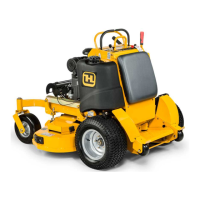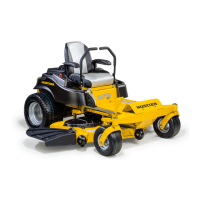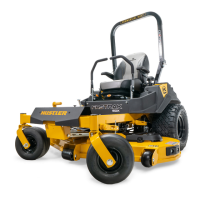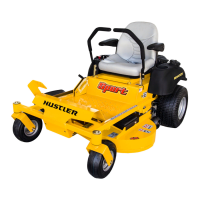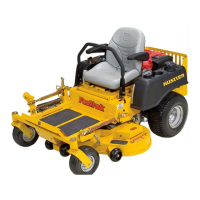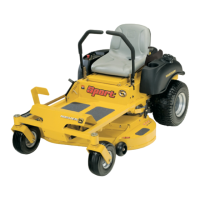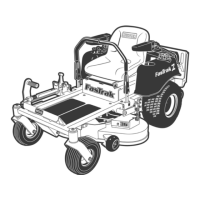127180 2-3 REV A
Always keep belt covers on mower deck for safety as
well as for cleanliness except when changing or
checking the belt.
Use a stick or similar instrument to clean under the
mower making sure that no part of the body, especially
arms and hands are under mower.
Keep your machine clean and remove any deposits of
trash and clippings, which can cause engine fires and
hydraulic overheating as well as excessive belt wear.
Clean up oil or fuel spillage. Allow machine to cool
before storing.
Always wear adequate eye protection when:
• servicing the hydraulic system.
• servicing the battery.
• grinding mower blades and removing
accumulated debris.
Never attempt to make any adjustments or repairs to
the mower drive system, mower deck or any
attachment while the engine is running or deck clutch
is engaged.
Exercise caution when releasing spring tension from
any of the belt idlers or when working with any of the
deck lift components.
Never work under the machine or attachment unless it
is safely supported with jack stands.
• Make certain machine is secure when it is raised
and placed on the jack stands.
• The jack stands should not allow the machine to
move when the engine is running and the drive
wheels are rotating.
• Use only certified jack stands. Use only
appropriate jack stands, with a minimum weight
rating of 2000 pounds (907 kg) to block the unit
up.
• Use in pairs only.
• Follow the instructions supplied with the jack
stands.
Do not touch hot parts of machine.Keep nuts and bolts
tight, especially the blade attachment bolts. Keep
equipment in good working condition.
Never tamper with safety devices. Check their proper
operation regularly.
Exercise caution when working under the deck as the
mower blades are extremely sharp. Wrap the blade(s)
or wear gloves and use extra caution when servicing
them.
Use original Hustler
®
replacement parts or parts that
are equivalent in overall performance.
• The mower may not comply with the appropriate
safety standards if aftermarket parts,
accessories, or attachments are used.
Maintenance Precautions
Avoid Fire Hazards
Be prepared if an accident or fire should occur. Know
where the first aid kit and the fire extinguishers are
located and how to use them.
Provide adequate ventilation when charging batteries.
Do not smoke near battery.
Never check fuel level with an open flame.
Never use an open flame to look for leaks anywhere on
the equipment.
Never use an open flame as light anywhere on or
around the equipment.
When preparing engine for storage, remember that fuel
stabilizer is volatile and therefore dangerous. Seal and
tape openings after adding the inhibitor. Keep
container tightly closed when not in use.
Inspect electrical wiring for worn or frayed insulation.
Install new wiring if wires are damaged.
Prepare for Emergencies
Be prepared if a fire starts.
Keep a first aid kit and fire extinguishers available.
Keep emergency numbers for doctor, ambulance
service, hospital, and fire department near the
telephone.
Prevent Battery Explosions
Battery posts, terminals, and related accessories
contain lead and lead compounds, chemicals known to
the State of California to cause cancer and
reproductive harm. Wash hands after handling.
Charge batteries in a well-ventilated open area, away
from sparks and flames. Unplug charger before
connecting or disconnecting from battery. Wear
protective clothing and use insulated tools.
Avoid skin and clothing contact with battery acid.
• Always wear eye protection when checking the
battery. Acid can cause serious injury to skin and
eyes. If contact occurs, flush area with clean
water and call a physician immediately. Acid will
also damage clothing.
• Do not drink the battery electrolyte.
• Do not allow open flame near the battery when
charging.
• Hydrogen gas forms inside the battery. This gas
is both toxic and flammable and may cause an
explosion if exposed to flame. Always disconnect
the negative (black) battery cable(s) before
disconnecting the positive (red) cable(s). Always
connect the positive (red) battery cable(s) before
connecting the negative (black) cable(s).
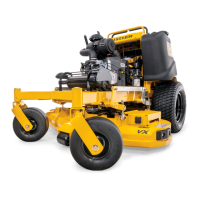
